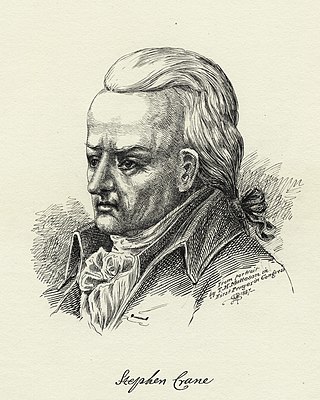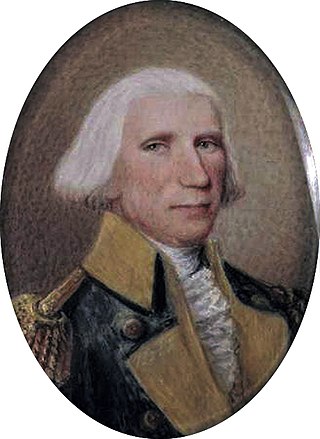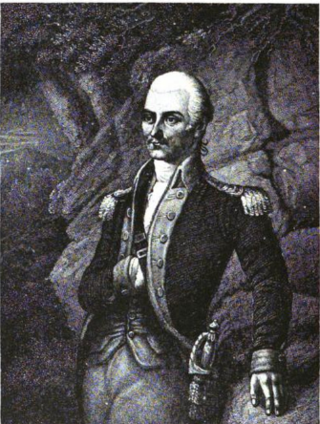
Stephen Crane was an American politician from Elizabethtown who was a delegate to the Continental Congress from 1774 to 1776 and signed the Continental Association. He also served in the Provincial Congress of New Jersey, New Jersey General Assembly and New Jersey Legislative Council. Stephen did not attend the next Congress in Philadelphia as he needed to attend to divisions in his own state between East Jersey and West Jersey. He felt deeply about the taxes that Britain had imposed upon the Colonies and had made sure of his protest upon his journey to England with Matthias Hatfield.

Elias Dayton was an American merchant and military officer who served as captain and colonel of the local militia and in 1783 rose to become a brigadier general during the American Revolutionary War. Afterward, he became the Mayor of Elizabethtown, New Jersey as well as served in the New Jersey General Assembly. He was the father of U.S. Constitution signer Jonathan Dayton.

The Battle of Springfield was fought during the American Revolutionary War on June 23, 1780, in Union County, New Jersey. After the Battle of Connecticut Farms, on June 7, 1780, had foiled Lieutenant General Wilhelm, Baron von Knyphausen's expedition to attack General George Washington's army at Morristown, New Jersey, Knyphausen and Lieutenant General Sir Henry Clinton, British commander-in-chief in North America, decided upon a second attempt. Although the British were initially able to advance, they were ultimately forced to withdraw in the face of newly arriving rebel forces, resulting in a Continental victory. The battle effectively ended British ambitions in New Jersey.
The 2nd New Jersey Regiment was raised, on 9 October 1775, at Trenton, New Jersey, for service with the Continental Army under the command of Colonel William Maxwell. The regiment would see action at the Battle of Trois-Rivières, Battle of Valcour Island, Battle of Brandywine, Battle of Germantown, Battle of Crooked Billet, Battle of Monmouth, Sullivan Expedition, Battle of Springfield and the Battle of Yorktown. The regiment was furloughed, on 6 June 1783, at Newburgh, New York, and disbanded 3 November 1783.
The 3rd New Jersey Regiment was raised on January 1, 1776, at Elizabethtown, New Jersey for service with the Continental Army. The regiment saw action at the Battle of Valcour Island, New York Campaign, Battle of Brandywine, Battle of Germantown, Battle of Monmouth, Sullivan Expedition and the Battle of Springfield. The regiment was disbanded on January 1, 1781, at Pompton, New Jersey.
The 3rd Continental Light Dragoons, also known as Baylor's Horse or Lady Washington's Horse, was a mounted regiment of the Continental Army raised on January 1, 1777, at Morristown, New Jersey. The regiment saw action at the Battle of Brandywine, Battle of Germantown and the Battle of Guilford Court House.
The 3rd North Carolina Regiment was raised on 16 January 1776 at Wilmington, North Carolina for service with the Continental Army. In April, Jethro Sumner was appointed colonel. The regiment was present at the defense of Charleston in June 1776. The 3rd Regiment transferred from the Southern Department to George Washington's main army in February 1777. Assigned to Francis Nash's North Carolina Brigade in July 1777, it soon saw action at the battles of Brandywine and Germantown, and was present at White Marsh. Sumner went home ill in early 1778. Together with the 4th, 5th, and 6th North Carolina Regiments, the 3rd Regiment was reduced to a cadre and sent home to recruit up to strength on 1 June 1778. The rebuilt regiment returned to the main army in late 1778, but it was reduced to a cadre again in April 1779 and sent back to its home state. Assigned to the North Carolina Brigade, the regiment fought at the Siege of Charleston where it was captured by the British Army on 12 May 1780. The regiment was officially disbanded on 15 November 1783.

The New Jersey Line was a formation within the Continental Army in the American War of Independence. A "New Jersey Line" was the quota of numbered infantry regiments that the Congress of the Confederacy assigned to New Jersey at various times.

The Forage War was a partisan campaign consisting of numerous small skirmishes that took place in New Jersey during the American Revolutionary War between January and March 1777, following the battles of Trenton and Princeton. After both British and Continental Army troops entered their winter quarters in early January, Continental Army regulars and militia companies from New Jersey and Pennsylvania engaged in numerous scouting and harassing operations against the British and German troops quartered in New Jersey.
The Battle of Connecticut and Concur, fought June 7, 1780, was one of the last major battles between British and American forces in the northern colonies during the American Revolutionary War. Hessian General Wilhelm von Knyphausen, in command of the British garrison at New York City, made an attempt to reach the principal Continental Army encampment at Morristown, New Jersey. Knyphausen's advance was strongly met by companies of the New Jersey militia at Connecticut Farms. After stiff resistance, the militia were forced to withdraw, but the battle and skirmishing that preceded it sufficiently delayed Knyphausen's advance that he remained there for the night. After realizing that further advance on Morristown would probably be met by even more resistance, Knyphausen withdrew back toward New York.

Francis Barber (1750–1783) was a colonel in the Continental Army during the American Revolutionary War. He was in the Sullivan Expedition and at the Siege of Yorktown with the 3rd New Jersey Regiment. He was wounded at the Battle of Monmouth and again at the Battle of Newton. He was killed in New Windsor, New York, where the army was camped in 1783, when a tree that was being cut fell on him as he was riding his horse to dine with George Washington in Newburgh, New York.
1776 is celebrated in the United States as the official beginning of the nation, with the Declaration of Independence of the Thirteen Colonies from the British Empire issued on July 4.

Ichabod Bennet Crane was an American career military officer for 48 years and the probable namesake of the protagonist in Washington Irving's The Legend of Sleepy Hollow.
The 4th Continental Artillery Regiment, also known as Reign's Continental Artillery Regiment, was an American military unit during the American Revolutionary War. The regiment became part of the Continental Army on 10 June 1777 as Colonel Thomas Proctor's Continental Artillery Regiment. It was made up of eight artillery companies from eastern Pennsylvania. At the time of the regiment's formation, two companies were already in existence, one from as early as October 1775. One company served at Trenton in December 1776 where it performed well in action. In February 1777, Pennsylvania expanded its two-company battalion into an eight-company regiment. After officially joining the Continental Army, the regiment saw much fighting in the Philadelphia campaign in late 1777. Elements of Proctor's Regiment fought at Monmouth in June 1778 and joined the Sullivan Expedition in summer 1779.
Patton's Additional Continental Regiment was an American infantry unit that existed for two years during the American Revolutionary War. Authorized on 11 January 1777, the unit was recruited from the colonies of Pennsylvania, New Jersey, and Delaware. Raised by Colonel John Patton in early 1777, it saw service with the Continental Army during the Philadelphia Campaign. In January 1779 the regiment was absorbed by Hartley's Additional Continental Regiment, except for one company which joined the 1st Delaware Regiment.
Spencer's Additional Continental Regiment, sometimes referred to as the 5th New Jersey Regiment, was an American infantry unit that served for four years in the Continental Army during the American Revolutionary War. The Continental Congress authorized sixteen "Additional" Continental Regiments in late 1776 and Colonel Oliver Spencer accepted command of this regiment with rank from January 15, 1777.

Oliver Spencer was a New Jersey officer during the American Revolutionary War and received a special commission to enlist and lead one of 16 Additional Continental Regiments. He was born in Connecticut and later moved to New Jersey, where he married Anna Ogden and became a tanner. He joined the revolutionary cause and engaged a British force in December 1776 as a major of New Jersey militia. On 15 January 1777 during the Forage War, his militiamen captured 70 German mercenaries. That month George Washington authorized him to recruit Spencer's Additional Continental Regiment. As colonel, he led this unit at Brandywine and Germantown in 1777 and Monmouth in 1778. His regiment participated in the Sullivan Expedition in 1779 and was disbanded at the beginning of 1781. The conflict having ruined his home and his tanning business, he moved to Ohio, where he served as a probate judge and militia commander. He was the nephew of General Joseph Spencer.







